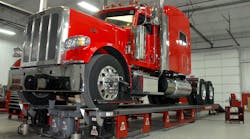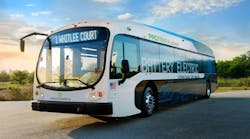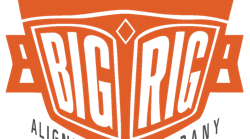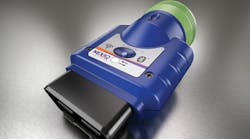When a vehicle is properly aligned, simply put, all of the vehicle’s wheels move in the same direction. In theory, this seems obvious but in practice, it can be more of a challenge.
With the number of miles put on each day and the transportation of heavy loads, the suspension and steering systems of a vehicle can become misaligned at any given time for a number of reasons. When out of alignment, further issues occur including increased uneven tire wear and greater fuel consumption - the two highest expenses for fleets.
Having the capability to complete a total vehicle alignment – measuring and adjusting all alignment angles – is a beneficial practice for fleets. This service can be completed in the shop or outsourced to another service facility.
Fleets looking to bring alignment in-house should review best practices for establishing a total vehicle alignment program. This includes researching equipment options and tools needed, assessing where the service will be completed in the shop, and identifying the technician training necessary to complete alignments safely and accurately.
Benefits of vehicle alignment
A total vehicle alignment should be completed on a regular basis. The Technology and Maintenance Council (TMC) Recommended Practice (RP) 642, Total Vehicle Alignment: Recommendations for Maximizing Tire and Alignment-Related Component Life, states an alignment should be done every 80,000 to 100,000 miles, or anytime a component that affects alignment is replaced, the vehicle should be realigned.
TMC RP 642 also suggests a “post break-in” alignment check should occur between 15,000 and 30,000 miles, but no later than 90 days after the vehicle goes in service.
Potholes, curbs, rough roads, and excessive loading can cause a vehicle to go out of alignment, says Steve Lemnah, heavy duty product manager at Hunter Engineering Company, a manufacturer in alignment systems and wheel and tire service.
Indications that a vehicle is out of alignment may include uneven tire wear, the vehicle pulling to one side, increased fuel consumption, or an off-center steering wheel when the vehicle is being operated in a straight direction.
“Typically, the first thing that will show up is tire wear,” says John Knutson, technical support and warranty manager for heavy duty vehicle suspension system and component provider Hendrickson. “Incorrect alignment can force the tires to scrub against each other and break traction resulting in increased horsepower demands and higher fuel consumption.”
“Vehicle alignment ultimately affects cost per mile,” Knutson adds.
A vehicle out of alignment also greatly affects the driver. Drivability can become difficult, and the driver may experience fatigue trying to keep the truck straight while going down the road.
In-shop advantages
Being able to complete maintenance and repair services on-site, within the fleet's own shop, offers not only a great deal of convenience for both the technician and driver, but it also provides significant benefits for fleets in general. For alignments, there are two main advantages: control and cost.
Fleets are able to have tighter control over how the total vehicle alignment is handled. This includes factors such as who completes the service (and whether that person is properly trained), the additional flexibility with service scheduling, and the quality control.
“With [total vehicle alignment] being in-house, [fleets] don’t have to take the vehicle out and deliver it somewhere. They don’t have to take up the time of a driver to take it there and either wait for it or drop it off and be out of service that whole time,” says Howard Williams, corporate technical sales specialist at Bee Line Company. “Whereas, if in-house, they can bring [the vehicle] in, get it done while the driver is doing his break, and get it back out. They control the situation.”
Bee Line Company is a manufacturer of computer laser wheel alignment, on-truck tire balancing, and frame correction equipment for heavy duty trucks and trailers.
“It also ensures a vehicle alignment is getting done on a regular basis and they know how it’s being done,” Williams adds.
Additionally, outsourced alignment service can cost more for fleets.
“When a truck is sublet out for [an alignment], there are additional costs involved such as labor times to deliver the truck and pick it up, added insurance costs to cover accidents while driving the truck, turn-around time at the alignment shop, and quality control issues,” says Hunter Engineering’s Lemnah.
“If you’re able to control your costs and control your own destiny and your maintenance program, you are able to continue down a better path,” says Lesley Cooke, president of Tru-Line Laser Alignment, manufacturer of laser wheel alignment systems. “For a fleet to have alignment as part of their service is a good financial move.”
So, when does it make sense for a fleet to acquire its own vehicle alignment equipment?
According to Lemnah, fleets should look at the types of repairs that are being done [in-house], the time it takes for technicians to complete them, and the cost of the repairs.
“Alignments are quick turnaround, high volume, and provide measurable savings,” Lemnah adds.
When a fleet is looking to complete the service themselves, John Ashal, president of Big Rig Alignment, says, “If you’re going to do it, do it right.” Big Rig Alignment offers planning, design, installation, and training for the OEM heavy duty wheel alignment industry.
“It requires focus and commitment,” Ashal says of completing alignment service in-house. “It’s not just buying a piece of equipment and then taking the manual, giving it to one of your technicians and say[ing] ‘Here, this is what we want you to do.’”
Equipment and tools needed
When a fleet decides to establish their own vehicle alignment program, the first step is to research equipment options.
Completing a vehicle alignment requires gauging equipment, inspection equipment, and a tire balancer, as well as some basic and specialty tools to complete the adjustments, Big Rig Alignment’s Ashal says.
“The centerpiece of [vehicle alignment] will be gauging equipment, which a lot of people call an alignment machine,” Ashal says. “It doesn’t actually align your vehicle; it just gauges your vehicle.”
Aligning a car is different from aligning a truck. Trucks have a lateral offset. This means that during the alignment process a technician must not only get all the wheels rolling in the right direction, but also ensure the vehicle frame is straight. Ashal recommends that heavy duty gauging equipment be frame referenced.
“Referencing the frame when adjusting the axles usually involves an extra step like putting some type of gauging unit on the frame, but it takes less time to do that than it would be to measure lateral offset manually,” Ashal says.
He also advises looking for gauging equipment that is repeatable. In other words, can a technician measure the same truck twice and get the same reading? A quality system includes not just the sensors or lasers, but also the hardware.
“Every system will have a ‘red’ and ‘green,’[indicator light] but it doesn’t do you any good if that red and green aren’t repeatable and that they don’t reflect the reality of how that truck really is,” Ashal says.
Also, when researching gauging equipment, fleets should consider all the equipment’s features and whether that equipment will meet all their needs. Some additional features to consider, according to Hunter’s Lemnah, include: “Ease of use, time it takes to generate measurements, live adjustment capability, trailer alignment capabilities, complete vehicle data, and portability.”
Alignment machines require regular calibration to ensure the most accurate results. Calibration involves referencing a zero point for all sensors to confirm accurate alignment readings. It is important to check with the alignment equipment manufacturer for the recommended calibration service and/or procedure.
In general, there are two types of calibration. For some equipment, a separate calibration bar or fixture — which is a precision machined part — is used for calibration. Other equipment may use a camera system, in which a camera is mounted on a wheel and uses a stationary target or fixture for calibration.
Whatever the calibration procedure, it's best when done by a technician in-house, suggests Bee Line’s Williams. He says having a separate manufacturer’s service call for the alignment equipment could result in added cost and downtime.
“If your equipment is out of calibration, you’re going to be adjusting the truck to the wrong geometry,” Ashal adds. “If you calibrate it yourself, you have control over how often it gets calibrated. If you have to send it in or have someone come out to do it, it’s usually expensive.”
Completing a thorough inspection of the vehicle prior to doing an alignment is also essential. This is known as a pre-alignment check. A vehicle must not contain any loose parts and must be in sound condition.
For the inspection process, Ashal recommends installing inspection plates in the shop flooring. The inspection plates make the alignment process more systematic and much faster. When the truck is driven onto these plates, the plates hydraulically move in and out, and back and forth. If there is any play in any mechanical piece of the vehicle it will be apparent, Ashal notes.
Additionally, a tire balancer is recommended when completing a vehicle alignment. Since tires are heavily affected by misaligned vehicles, it only makes sense for fleets to incorporate tire maintenance within their vehicle alignment program.
When it comes to tools needed for vehicle alignments, most are already available in a shop. According to Ashal, these include items such as a bearing adjustment tool, induction heater, tie-rod separator, tie-rod socket, centering pins, brake adjustment tools, shims and wedges, spindle nut sockets, stud/nut cleaning tools, lug nut cover tools, tie-rod air hammer, assorted combination wrenches, assorted impact sockets, a grease gun, pry bars, and hammers.
Other considerations
Next, fleets need to plan where the vehicle alignment equipment will be located. Will the shop have a dedicated service bay for vehicle alignments? Will the location of service vary and require portable equipment? The environment must be a flat surface and a large enough area to fit the vehicle and all necessary equipment.
Once the equipment has been acquired and the location has been established, technician training is the next crucial step.
“Technician training is strongly recommended to ensure an understanding of how the equipment operates and what the alignment readings are telling them about the truck,” Hendrickson’s Knutson says.
Many alignment system companies include setup and on-site training upon purchase. Some may even provide additional training, if requested, on-site or at the company’s facility.
Similar to researching the alignment equipment, it is also best to make sure the company representative is knowledgeable in vehicle alignments.
“I’ve seen trainers who come in and just say to throw this on, do this, adjust it until it’s in the green, then take the equipment off, and you’re done,” Ashal says. “Whoever is doing the training has to stress how to properly use the equipment to get the correct numbers.”
It’s imperative for a technician to know from the start how to handle the alignment equipment, capture the correct measurements, and make the correct adjustments. If not done properly, it won’t take long for the vehicle to end up back in the shop.
Evaluating the success of the program
After establishing a vehicle alignment program, it is important for fleets to evaluate its success. By doing so, fleets can determine the program’s overall effectiveness and learn where improvements can be made.
According to TMC’s RP 642, proper records help judge the overall effectiveness of a maintenance program and provide support for changes in personnel, equipment, facilities, or procedures. Good recordkeeping can also help a fleet decide if an annual alignment is best, or if six-, nine-, or 18-month intervals would be more cost-effective.
One way to calculate the success of a vehicle alignment program is to compare tire and fuel expenses from before implementation to after.
“Fleets that have implemented alignment programs usually see a reduction in operating expenses, providing a good return on investment,” Hunter Engineering’s Lemnah says.
When fleets establish an in-house vehicle alignment program, it cannot only provide convenience but also cost savings and control. With the number of expenses that fleets already face, being able to have a better handle on tire wear and fuel mileage can prove beneficial.






